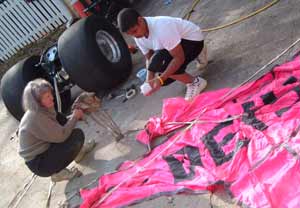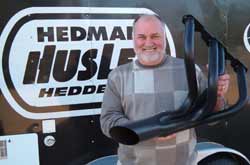| More of Richard
Earle’s Tech Tips
Story and photos by Dale
Wilson
1/7/05
In a previous issue, we brought you some tech tips by chassis
builder Richard Earle of Suncoast Race Cars in Homosassa,
Florida. Richard has been in the drag racing game for more
than 30 years, building everything from Pro Modifieds to bracket
bombers. He has learned a few tricks along the way. Here are
some more.
  "Concerning
parachutes: You either need to use them frequently or take
them out of the pack and stretch them out. Why? Because if
they stay folded up in the pack, they have a tendency to rip
on the folds. One customer of mine hadn’t popped his
since 1992. We had to put a new one on his race car. It was
deteriorated. Probably mildew. You couldn't tell anything
was wrong with it from the outside, but you can’t take
a chance. We also recommend putting baby powder or talc in
the folds of any parachute when you repack it." "Concerning
parachutes: You either need to use them frequently or take
them out of the pack and stretch them out. Why? Because if
they stay folded up in the pack, they have a tendency to rip
on the folds. One customer of mine hadn’t popped his
since 1992. We had to put a new one on his race car. It was
deteriorated. Probably mildew. You couldn't tell anything
was wrong with it from the outside, but you can’t take
a chance. We also recommend putting baby powder or talc in
the folds of any parachute when you repack it."
  "Powder-coat
the inside of headers when new if possible – at least
the collectors. Why? It makes them last, stops the rust process,
and you can actually pick up horsepower by retaining the heat
inside the tube, just like with the outside of the tube, because
it eases the flow of spent gasses to the outside." "Powder-coat
the inside of headers when new if possible – at least
the collectors. Why? It makes them last, stops the rust process,
and you can actually pick up horsepower by retaining the heat
inside the tube, just like with the outside of the tube, because
it eases the flow of spent gasses to the outside."
(Dale's note --- We had our new Hedman South Hedman Hedders
coated inside and out, and on our dragster, they seem to flows
the spent gasses out better. Try it yourself.)
ADVERTISEMENT
 |
|
 "John
Winters of J.W. Performance Transmissions (Rockledge, FL)
told me to do this years ago. Tie a pressure valve into the
servo in your transmission and monitor it through a gauge
just like you would oil pressure. It’s like with valve
springs in a new engine – when you first put it together,
you see what the springs read. With a pressure gauge, you
also see what the pressure in your transmission reads, and
then if it starts to drop off or vary, you know you have a
trans problem. You can stop a lot of problems before they
start. Your pressure will vary from trans to trans, so that’s
why you get a baseline reading when you first put it in. Good
pressure should be between 200 and 250 pounds." "John
Winters of J.W. Performance Transmissions (Rockledge, FL)
told me to do this years ago. Tie a pressure valve into the
servo in your transmission and monitor it through a gauge
just like you would oil pressure. It’s like with valve
springs in a new engine – when you first put it together,
you see what the springs read. With a pressure gauge, you
also see what the pressure in your transmission reads, and
then if it starts to drop off or vary, you know you have a
trans problem. You can stop a lot of problems before they
start. Your pressure will vary from trans to trans, so that’s
why you get a baseline reading when you first put it in. Good
pressure should be between 200 and 250 pounds."
 "Most
people don’t know how to properly set a line lock on
a burnout. Here’s the way I recommend. Put the car in
the water, set the button on the line lock, then pump the
pedal. You’ll build pressure with each consecutive pump.
We recommend a brake pressure gauge in our cars. You’ll
get more holding pressure if you set the button first, then
pump the brakes. If you pump it up and then set it, you’re
just getting the pressure of your last pump. Auto Meter (Sycamore,
Ill) has an electric brake pressure gauge that we use, and
it is easier to install." "Most
people don’t know how to properly set a line lock on
a burnout. Here’s the way I recommend. Put the car in
the water, set the button on the line lock, then pump the
pedal. You’ll build pressure with each consecutive pump.
We recommend a brake pressure gauge in our cars. You’ll
get more holding pressure if you set the button first, then
pump the brakes. If you pump it up and then set it, you’re
just getting the pressure of your last pump. Auto Meter (Sycamore,
Ill) has an electric brake pressure gauge that we use, and
it is easier to install."
 "Again,
concerning the engine and trans, you should check the electric
fuel pump volume from time to time by seeing how much will
pump into a gallon container. It should pump a gallon in 13
or 14 seconds. Anything slower and you may have a fuel problem.
It could be pickup, not enough fuel volume, a lot of things.
And always take the line loose after the regulator, at the
carburetor. With today’s engines, you have to be able
to flow that much fuel." "Again,
concerning the engine and trans, you should check the electric
fuel pump volume from time to time by seeing how much will
pump into a gallon container. It should pump a gallon in 13
or 14 seconds. Anything slower and you may have a fuel problem.
It could be pickup, not enough fuel volume, a lot of things.
And always take the line loose after the regulator, at the
carburetor. With today’s engines, you have to be able
to flow that much fuel."

|
